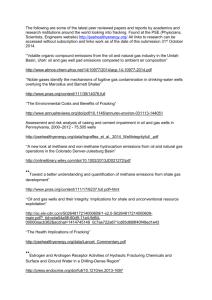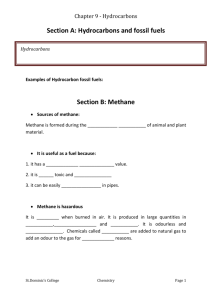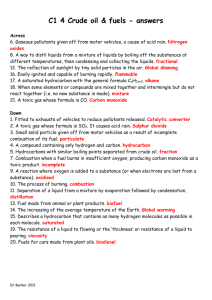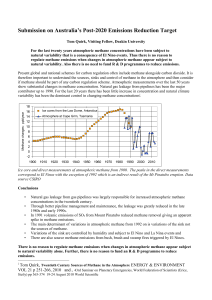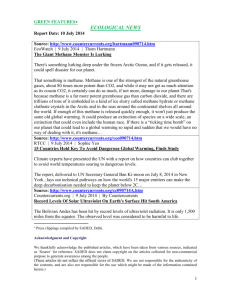CCAC OIL AND GAS INITIATIVE * TECHNOLOGY
advertisement
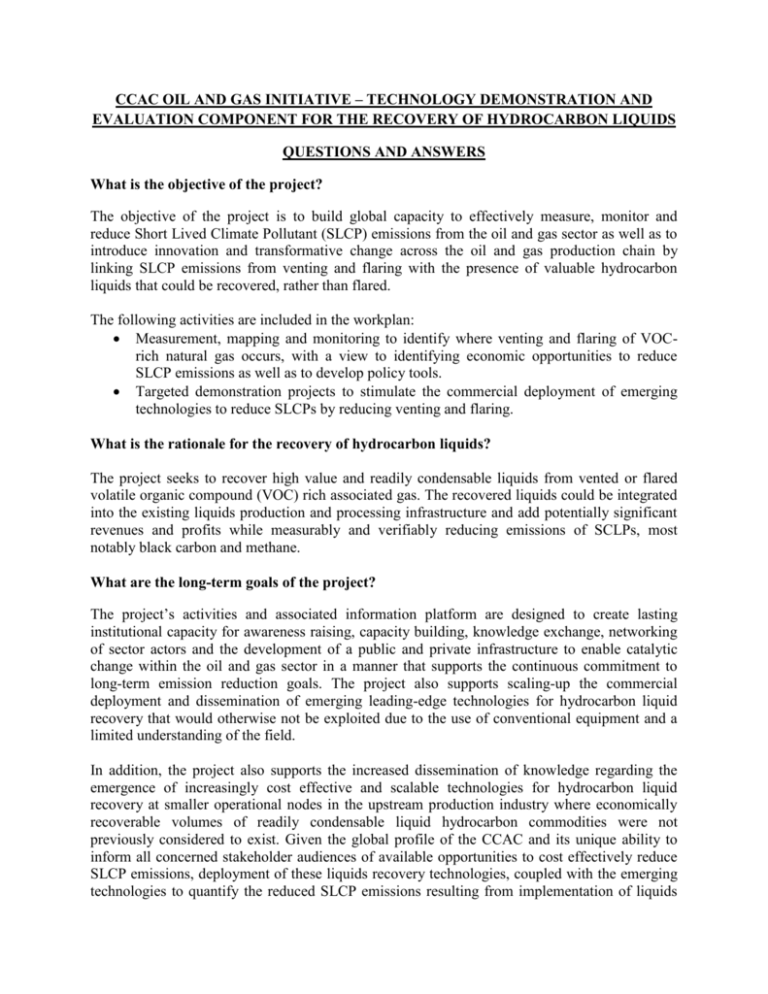
CCAC OIL AND GAS INITIATIVE – TECHNOLOGY DEMONSTRATION AND EVALUATION COMPONENT FOR THE RECOVERY OF HYDROCARBON LIQUIDS QUESTIONS AND ANSWERS What is the objective of the project? The objective of the project is to build global capacity to effectively measure, monitor and reduce Short Lived Climate Pollutant (SLCP) emissions from the oil and gas sector as well as to introduce innovation and transformative change across the oil and gas production chain by linking SLCP emissions from venting and flaring with the presence of valuable hydrocarbon liquids that could be recovered, rather than flared. The following activities are included in the workplan: Measurement, mapping and monitoring to identify where venting and flaring of VOCrich natural gas occurs, with a view to identifying economic opportunities to reduce SLCP emissions as well as to develop policy tools. Targeted demonstration projects to stimulate the commercial deployment of emerging technologies to reduce SLCPs by reducing venting and flaring. What is the rationale for the recovery of hydrocarbon liquids? The project seeks to recover high value and readily condensable liquids from vented or flared volatile organic compound (VOC) rich associated gas. The recovered liquids could be integrated into the existing liquids production and processing infrastructure and add potentially significant revenues and profits while measurably and verifiably reducing emissions of SCLPs, most notably black carbon and methane. What are the long-term goals of the project? The project’s activities and associated information platform are designed to create lasting institutional capacity for awareness raising, capacity building, knowledge exchange, networking of sector actors and the development of a public and private infrastructure to enable catalytic change within the oil and gas sector in a manner that supports the continuous commitment to long-term emission reduction goals. The project also supports scaling-up the commercial deployment and dissemination of emerging leading-edge technologies for hydrocarbon liquid recovery that would otherwise not be exploited due to the use of conventional equipment and a limited understanding of the field. In addition, the project also supports the increased dissemination of knowledge regarding the emergence of increasingly cost effective and scalable technologies for hydrocarbon liquid recovery at smaller operational nodes in the upstream production industry where economically recoverable volumes of readily condensable liquid hydrocarbon commodities were not previously considered to exist. Given the global profile of the CCAC and its unique ability to inform all concerned stakeholder audiences of available opportunities to cost effectively reduce SLCP emissions, deployment of these liquids recovery technologies, coupled with the emerging technologies to quantify the reduced SLCP emissions resulting from implementation of liquids recovery, and the application of rigorous petroleum accounting and economics practices to verify all costs and payback periods, constitutes a significant component of the demonstration phase of this project. What are the expected results? The component for the recovery of hydrocarbon liquids is expected to support: (1) increased capacity for accurate measurement and economic evaluation of emissions reduction opportunities from flaring and venting of VOC rich natural gas; (2) the dissemination of information and best practices regarding replicable near, medium and long term SLCP emissions reductions of methane and black carbon emissions; (3) the development of policy and technical tools to enable measurement or quantification, mapping and monitoring; and (4) promote the transfer and replication of demonstrated technologies and practices. What is VOC rich natural gas and why can liquid hydrocarbons be extracted from VOC rich natural gas? Natural gas is typically a mixture of methane and additional chemically different light hydrocarbon species, also known as volatile organic compounds or VOC, which all happen to be in the gas or vapor phase when the ambient temperature or pressure of a particular environment prevents any of the individual hydrocarbon species vapors from condensing to become a liquid(s). All of the individual VOC species in natural gas have varying degrees of volatility, which means they evaporate or condense at different pressures or temperatures. Light hydrocarbons such as methane preferentially remain in the gas or vapor phase at normal atmospheric temperatures or pressures, and heavier hydrocarbons such as pentane or hexane can exist as liquids at normal atmospheric temperatures or pressures. These volatile liquids typically vaporize or evaporate due to the impact of elevated temperatures such as the high temperatures in the reservoirs from which they are produced or that are induced by mechanical processes in surface facilities. However, if the natural gas is allowed to cool, or is purposefully subjected to refrigeration, it becomes possible to liquefy hydrocarbon species such as pentane and hexane. If the natural gas is further cooled and subjected to higher pressures, it becomes possible to liquefy hydrocarbon species such as propane and butane. How does the recovery of liquefiable hydrocarbons from VOC rich natural gas reduce black carbon emissions and how can this be quantified? Due to the well understood, high degree of correlation between the qualitative or visible increase of black carbon soot generated from flaring, and the presence of readily condensable liquid hydrocarbon commodities in the flare fuel, removal of liquefiable hydrocarbons from flare streams will reduce or eliminate black carbon soot from flaring. Additionally, deployment of proposed demonstration technologies to quantify the mass flux of black carbon soot from flares prior to and after initiating the removal of liquefiable hydrocarbons from flare streams, will serve to quantify the black carbon emissions specifically associated with the flaring of liquefiable hydrocarbons. Subsequent economic evaluation of the revenue potential from the recovery of liquefiable hydrocarbon commodities, and the cost(s) of recovering these commodities, will enable precise determination of the profitable opportunities to quantifiably and verifiably reduce magnitudes of black carbon soot from flaring. What are the synergies between the Technology and Evaluation Component and the Methane Partnership? Under the CCAC’s Oil and Gas Initiative, both projects describe complementary work plans to support the Coalition’s objectives for the reduction of SLCP emissions. However, the focus of each of the components is significant and distinct. Different emissions sources may, in some cases, be co-located within a single large facility, but are more often located at distinctly separate locations within the oil and gas production system. Emission Sources The Methane Partnership identifies SLCP methane emissions from sources or operational nodes which are largely engaged in the handling or transport of very nearly pure or homogeneous streams of gaseous methane situated within, and down-stream of natural gas processing infrastructure in the oil and gas industry. Little or no new or additional economic opportunity to recover readily condensable liquefiable hydrocarbon commodities is considered to exist within this system boundary, that is not already being exploited by large scale condensation activities at facilities such as straddle plants which already exist along major methane pipeline corridors to remove trace residual quantities of commodities such a propane and butane from large volumes of already processed gas intended for delivery to methane consumers. Methane is considered to be the only economically recoverable hydrocarbon commodity around which to develop an economic business case for SLCP emissions mitigation from sources identified under the Methane Partnership. The Technology Demonstration and Evaluation Component for the Recovery of Liquid Hydrocarbons1 supports the implementation of SLCP mitigation of black carbon and methane with a specific emphasis on operational nodes such as venting and flaring which are clearly situated outside or upstream of the handling or transportation of nearly pure or homogeneous methane (i.e., oil production and natural gas liquids or condensate production), as described within the Methane Partnership. Although concentrations of methane within the targeted vent and flare streams can contribute significantly to GHG emissions, the economic value of the methane alone, relative to the economic value(s) of the available suite of readily condensable or liquefiable hydrocarbon commodities, is often negligible and has been demonstrated not to serve to support the successful development of an economic business case for emissions mitigation at 1 The project identifies that venting of liquids rich natural gas results in GHG and toxic VOC emissions and provides for significant economic opportunity if all hydrocarbon commodities (i.e., methane and the condensable VOC compounds such as ethane, propane, butane, which are known as liquefiable petroleum gases or LPG, and natural gas liquids or NGL such as pentane, hexane, octane etc) are identified, quantified, monetized and recovered. The clearly described methane benefit which is entirely unique to this project is the utilization of the recovered dry methane as fuel to generate electricity to power condensation technologies for liquids recovery instead of venting the methane to atmosphere. the emissions sources being targeted under the Recovery of Liquid Hydrocarbons component of the project. Industry Practices It is common industry practice to mechanically separate methane from VOC at natural gas processing facilities, in order to deliver clean burning methane fuel to consumers and this describes the fundamental business of the gas industry. This separation is typically facilitated using large scale refrigeration technologies designed to preferentially condense out the VOC content, leaving behind an essentially pure methane stream that may contain concentrations of ethane or propane, which are often later removed through further refrigeration at facilities known as straddle plants which are located along major gas pipeline corridors. Therefore, the predominant hydrocarbon commodity being emitted from sources identified under the Methane Partnership will be methane, given that VOC separation has been undertaken upstream of these emissions sources. Activities Under the CCAC’s Oil and Gas Initiative, both projects describe complementary work plans to support the Coalition’s objectives for the reduction of SLCP emissions. However, the focus of each of the components and their related activities are significantly different. The Methane Partnership proposes to work with upstream oil and natural gas companies to encourage comprehensive, yet flexible, methane management and mitigation actions to encourage increased: 1) knowledge of methane emissions levels from oil and gas operations, 2) methane emission reduction activities, and 3) recognition for companies that adopt rigorous best practice in the area of methane emission management. The Technology Demonstration and Evaluation Component for the Recovery of Liquid Hydrocarbons supports the implementation of SLCP mitigation of black carbon and methane with a specific emphasis on the emerging opportunity to cost effectively recover readily condensable hydrocarbon liquids that are otherwise vented or flared by the oil and gas industry, at operational nodes previously overlooked by operators for reasons attributable to technology or knowledge gaps and resulting inability for economic business case development. The liquids recovery activities will be coupled with application of emerging technologies to effectively and credibly quantify the reduced or avoided SLCP methane and black carbon emissions directly related to the recovered volumes of hydrocarbon liquid commodities, and their associated revenues. This provides a transformative opportunity for economically viable resource conservation and SLCP emissions reduction that is globally replicable and transferable. The Technology Demonstration and Evaluation Component for the Recovery of Liquid Hydrocarbons will advance knowledge and demonstration of black carbon and methane mitigation opportunities though two main activities: (1) measurement, mapping and monitoring to develop technical and policy tools and (2) targeted demonstration projects to stimulate the commercial deployment of emerging technologies In addition, the liquids recovery component specifically builds on work from 2011-13 with PEMEX (Mexico) and Colombia (ECOPETROL) that developed oil and gas industry sectorbased plans for Nationally Appropriate Mitigation Actions (NAMAs) to address energy efficiency, natural gas and liquids conservation and utilization, and reduction or elimination of venting and flaring of VOC rich natural gas and associated emissions of methane and black carbon SLCPs. Is the proposed work complimentary to other international clean energy partnerships? The GMI has been effective in promoting the uptake and implementation of technologies and practices to detect, quantify and reduce methane emissions from gas production. The Global Gas Flaring Reduction public-private partnership (GGFR) has been focused primarily on the management of large-scale flaring of stranded associated gas from primary oil production and brings around the table representatives of governments of oil-producing countries, state-owned companies and major international oil companies so that together they can overcome the barriers to reducing gas flaring by sharing global best practices and implementing country specific programs. The project seeks to complement these international clean energy partnerships by focusing on the recovery of hydrocarbon liquids streams as a core priority with a focus on promoting the awareness and uptake of knowledge and technologies regarding the detection, quantification and cost effective recovery of valuable light hydrocarbon liquids. The approach is based on experience gained through previous projects in developing countries; notably with the China National Petroleum Corporation, Ecopetrol and PEMEX where the realisation of previously overlooked opportunities for the recovery of hydrocarbon liquids produced a rigorous mitigation plan to support the achievement of economic and environmental targets directly linked to their domestic and international emission reduction obligations. How does the project support national and international commitments to SLCP emission reductions? Work currently underway in Colombia and Mexico is demonstrating how the findings and results from oil and gas projects are helping to integrate knowledge of SLCP reduction opportunities into decision-making and implementation at the national and international levels. In addition, these activities have provided a practical and current model for countries to work in close collaboration with the private sector to develop national emission reduction strategies for oil and gas sectors in developed and developing countries as well as high-emitting jurisdictions, based on the NAMA approach, which emphasizes the accurate, credible and verifiable quantification of opportunities to increase hydrocarbon recovery, energy efficiency and SLCP reductions in the oil and gas sector. How is the project linked to other CCAC and Coalition Activities? The CCAC’s Strategic National Action Plan Initiative (SNAP), Brick Kilns Initiative and Health Task Force are included in the project’s work plan for activities that detect, measure, map and quantify black carbon and methane emissions as well as demonstrating the negative secondary effects of SLCPs. The collaborative nature of the project promotes the efficient use of scarce financial resources, strengthens the advancement and transfer of knowledge and technologies as well as the development and integration of policies and programs to reduce SLCPs. Who will benefit from the project? The proposed work plan is intended to address non-commercial activities that fill a global gap in knowledge and capacity for measurement, mapping and the demonstration of technologies in the oil and gas sector which have not yet been addressed by either the public or private sector. The activities are intended to produce outcomes and results that could provide an overall public benefit through the development of a knowledge base and tools which would contribute to the development and implementation of policies, programmes and measures that align with mandatory regulatory requirements in addition to other global goals, objectives and targets for SLCP emission reductions. One example of this approach is Ecopetrol’s current collaboration in Colombia with its ministries of energy and the environment to plan and implement a national low-carbon strategy that includes a sectoral plan for emission reductions based on the 2011 NAMA project. Who will implement the programme? The Technology Demonstration and Evaluation Component for the Recovery of Liquid Hydrocarbons will be led by a Steering Committee of Country Partners who advise and provide guidance to a proposed lead implementer responsible for the administrative and financial management of operational aspect of the project. The following implementers are committed to the programme: the World Bank’s Global Gas Flaring Reduction Initiative (GGFR), International Cryosphere Climate Initiative, Carleton University, Petroleum Technology Alliance of Canada (PTAC), Further by Design, and Stockholm Environmental Institute (SEI).
